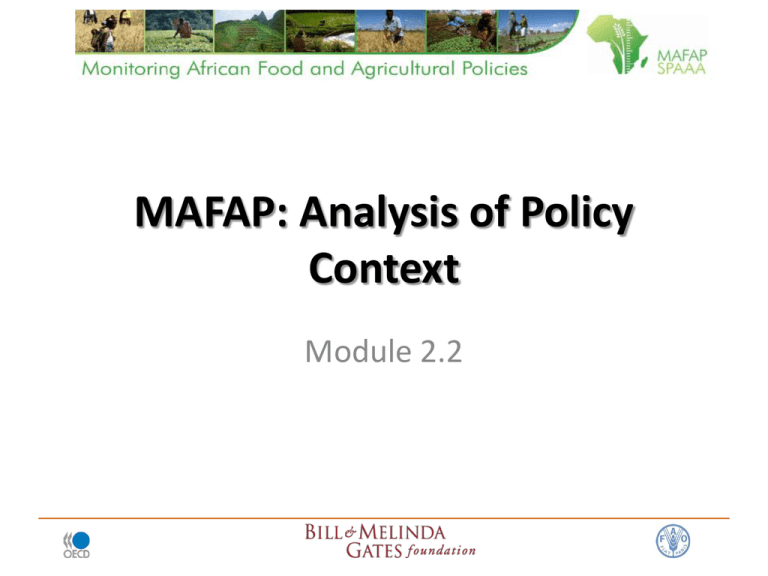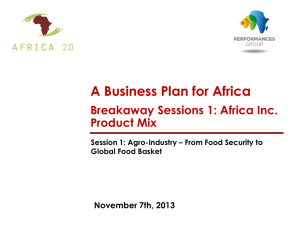MAFA P: Overview Methodology
advertisement

MAFAP: Analysis of Policy Context Module 2.2 Commodity Price Analysis and Government Policies Objective: To examine commodity market price incentives and analyze/evaluate the linkages of government policies including government investment policies to commodity price incentives. Commodity Price Analysis and Government Policies The goal of the this presentation is to briefly: Review the rational/goals of government policies. Review key policies and discuss their likely impacts on commodity price incentives. Stress the tradeoffs in policies (between various objectives such as efficiency, equity, etc.). Rationale for government policies • There is the belief that government intervention can accelerate growth. • To correct market failure/imperfection (examples of credit market in rural areas, market power, etc.). • To reduce the impacts of externalities (examples of environmental pollution, over utilization of resources creating soil erosion, etc.). Impacts of government policies The impacts depend on: • Objectives or goals of policy makers. • They are subject to constraints of the economic realities. • Depend on the instruments that governments use. Note: There are always tradeoffs in meeting different policy goals (we discuss the issue at the end of this session) General goals of government policies (1/2) • Efficient resource allocations to improve agricultural productivity is usually a key policy goal. • Globalization of trade, which is based on comparative advantage in production, makes efficiency of production mandatory if a country plans to get a sizeable market share in the highly competitive global trade market. • Equity of the income distribution (based on targeted policies toward special groups) to achieve more even income distribution is an important policy goal. General goals of government policies (2/2) • The goal of equity is that governments like to reduce the gap between low and high income population to reduce poverty and maintain social harmony. • Security goal aims at providing economic stability and in the case of food security refers to the availability of food at affordable and stable prices for all. Question: What are the key policy goals in Kenya? Key constraints limiting impacts of agricultural policies • Supply: domestic production is limited by resources, technologies, relative input prices, and management capabilities. • Demand: domestic consumption is limited by population, income, tastes, and relative product prices. • World Prices limit imports to increase domestic supply and to export to increase markets for domestic production. Question: what are the key constraints in agricultural production in Kenya? Types of policies affecting agricultural commodities: • Agricultural price policies: such policies tend to be commodity specific, either targeted to one or more commodities produced or can be targeted to agricultural inputs. • Macro-economic policies are country-wide policies and tend to affect all sectors of the economy. • Government investments are expenditures from the public budget. They can have different affect on diverse agricultural groups depending on the specific areas where the investment occurs. • Foreign government policies through aid and technical assistance Impacts of Agricultural Price Policies • Agricultural price policies will affect producers, consumers, and the government budget. • Depending on the type of policy, there will be transfers between two or all three groups. • This means in all cases one group loses and at least one other group benefits. Question: what are the key recent agricultural policy initiatives in Kenya? Taxes and subsidies For agricultural commodities such policies result in transfers between the public budget and producers and consumers. Taxes transfer resources to the government, whereas subsidies transfer resources away from the government. Example of fixed producer price policy (higher than the international prices): gain for producers; loss for consumers; increase in budget outlay that should be compensated by higher taxes. Price stabilization policies Such policies are adopted because of the high production variation causing market prices to fluctuate substantially from one production cycle to the next. Policies adopted for this purpose, include trade restrictions, price fixing, rationing, and storage schemes. Crop insurance and futures and options markets are institutions that reduce the uncertainty of prices and income but these institutions are not adopted by most developing countries. International trade restrictions • Taxes or quotas that limit either imports or exports changes domestic price levels and has impacts on both producers and consumers depending on the policy. • Import restrictions, for example, raise domestic prices above relative to world prices, while export restrictions lower domestic prices compare to world price. Question: what are the main policy tradeoffs? Factor price policies: traded and non-traded These policies directly affect agricultural costs of production. The case of traded inputs such as fertilizer use is straight forward i.e. domestic prices are compared with international prices to estimate taxes/subsidies. The non-traded inputs include land, labor, and capital. Land and labor costs, in general, account for a large share of the production costs of most agricultural commodities. Policies that can influence such costs include: • land rental rates, minimum wage, • interest rates, control of land use, and • water use/cost policies. Question and discussion 1. Question: what are the key policy goals in Kenya? 2. Question: what are the key constraints in agricultural production in Kenya? 3. Question: what are the key recent agricultural policy initiatives in Kenya? 4. Question: what are the main policy tradeoffs? Macro-economic Policies • Three categories of macro-economic policies affect agriculture: Monetary policies Fiscal policies Exchange rate policies Monetary and fiscal policies • These policies influence all sectors of the economy. The key is their impacts on the rate of price inflation (consumer or producer prices). • Monetary policies leading to increase supply of money leads to faster demand growth for goods thus puts pressure on inflation. • Similarly, inflation increases when government deficits are covered by expanding supply of money. Exchange rate policies • Exchange rates affect agricultural prices and costs of tradable goods (imports and exports) and in the estimations of price incentives, exchange rate misalignment needs to be estimated. • The exchange rate influences the price of an agricultural commodity because the domestic price (in local currency) of a tradable commodity is equal to the world price (in foreign currency) times the exchange rate (the ratio of domestic to foreign currency). Public Expenditure Policies Influencing Agriculture • Government budgetary resources can be spent on agriculture directly or indirectly to improve incomes, increase productivity and to reduce transaction costs. • The most common direct expenditures include production and input subsidies, direct payments, investments in infrastructure (on and off farm), investment in human capital (agricultural education and training, etc.), and in agriculture research and technology (and extension) while indirect expenditures include rural development measures (rural infrastructure, education, health). Public expenditures on input subsidies Input subsidies are implemented to enable farmers to use inputs and technologies that are known to be effective and intend to address in relatively simple manner otherwise difficult problems of developing input markets and associated financial services to small farmers. But inputs subsidies treat the symptoms rather than origins of market failures, distort resource allocation and are often costly and difficult to sustain without cutting expenditures on important public goods. Question/discussion: when and how to use input subsidies (SMART input subsidies) Public investments in research and technology (R&D) Such investments benefit both producers and consumers. These investments are very important for production growth; they tend to have strong long-term impacts although difficult to measure in terms of return to specific commodity in a given year. Question/discussion: public investment in R&D versus government policy of technology transfer (the example of biotech) Public investments in infrastructure • Infrastructure investment improves returns to producers or lowers costs of production. • Infrastructure investment includes investment in roads, ports, and irrigation networks (and can be on and off farm). Such investments tend to be targeted and benefit mostly the producers and consumers who live in those regions. Question/discussion: how to measure annual agricultural benefits of investment in irrigation network that has initial high costs with mid-term maintenance costs? Public investments in human capital These include wide variations of policies and include investment to improve the skill levels and health of producers and consumers. Investments in formal schools, training and extension centers, public health facilities, and clinics and hospitals are examples of such investment. These investments are very important for long-term development, but their short-terms impacts on prices difficult to measure. Question/discussion: direct versus indirect investment in human capital; the case of extension service: quality versus quantity of investment. Discussion on Policy Tradeoffs • Often gains for one policy goal result in losses for another (example of price subsidy and budget deficit or consumer and producer price subsidy). • Assigning weights to objectives of government policies are value judgments but the goal of analysis is to identify the appropriate tradeoffs between policies. • Quantitative analyses are critical for policymakers to examine the impacts of their policies (producers, consumers, budget, efficiency, equity, etc.). Question and discussion: 1. Question/discussion: when and how to use input subsidies (SMART input subsidies) 2. Question/discussion: public investment in R&D versus government policy of technology transfer (the example of biotech) 3. Question/discussion: how to measure annual agricultural benefits of investment in irrigation network that has initial high costs with mid-term maintenance costs? 4. Question/discussion: direct versus indirect investment in human capital; the case of extension service: quality versus quantity of investment. Thank you!





